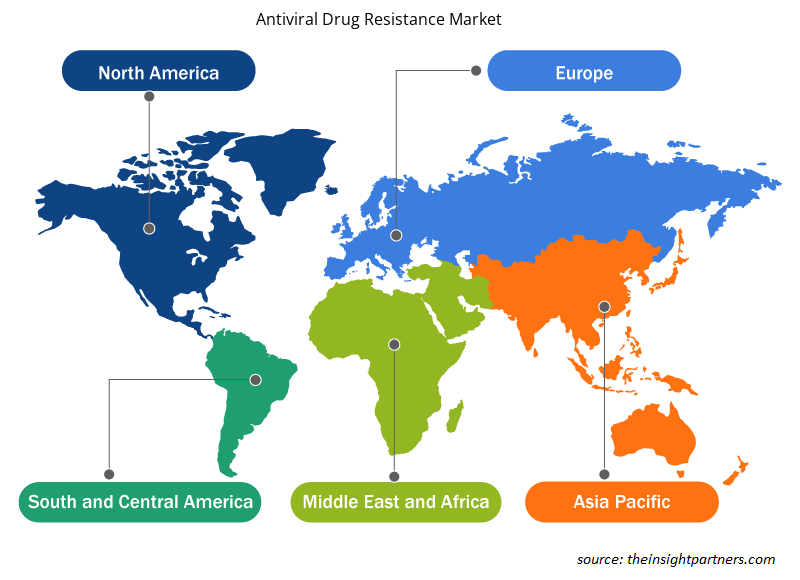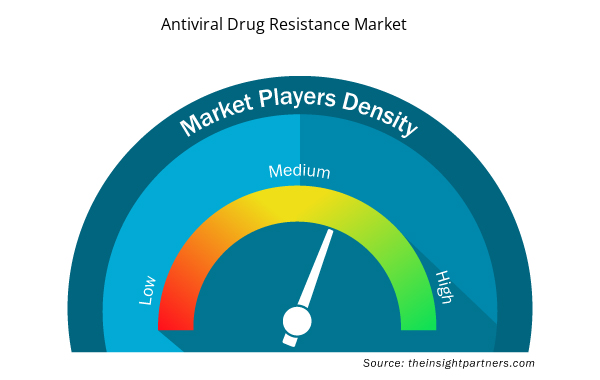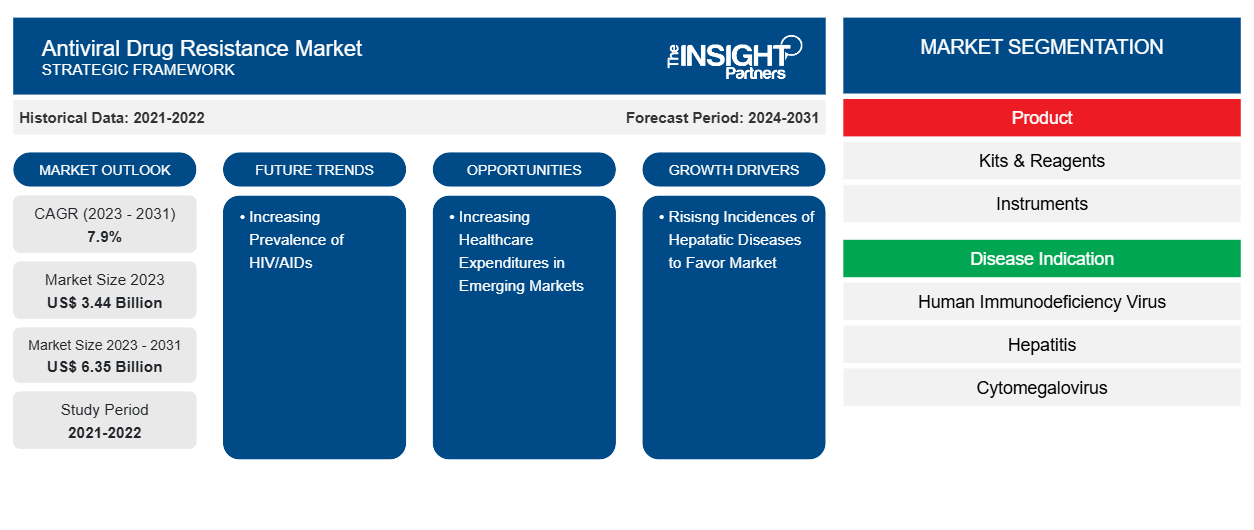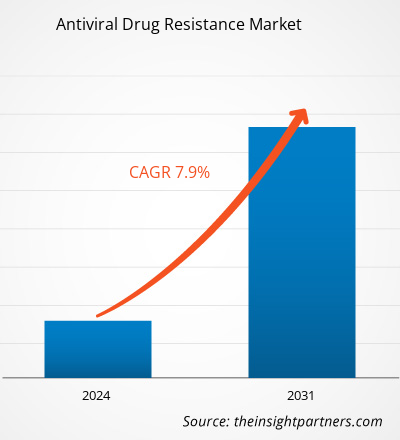Der Markt für antivirale Arzneimittelresistenzen soll von 3,44 Milliarden US-Dollar im Jahr 2023 auf 6,35 Milliarden US-Dollar im Jahr 2031 anwachsen. Für den Zeitraum 2023–2031 wird ein durchschnittliches jährliches Wachstum von 7,9 % erwartet. Die steigende Zahl von Lebererkrankungen, die Verbreitung von HIV und AIDS sowie die Nachfrage nach qualitativ hochwertigen Produkten in Schwellenländern dürften weiterhin wichtige Trends auf dem Markt bleiben.
Marktanalyse für antivirale Arzneimittelresistenz
Die Prävalenz von HIV/AIDS hat in den letzten Jahren weltweit zugenommen. Das erworbene Immunschwächesyndrom (AIDS) ist eine chronische, potenziell lebensbedrohliche Erkrankung, die durch ein menschliches Immunschwächevirus (HIV) verursacht wird. Das Virus ist für die Schädigung des Immunsystems verantwortlich, wobei HIV die Fähigkeit des Körpers beeinträchtigt, die krankheitserregenden Organismen zu bekämpfen. Wenn HIV in den Körper eindringt, entwickelt sich innerhalb eines Monats eine grippeähnliche Erkrankung. Diese Krankheit wird als primäre oder akute HIV-Infektion bezeichnet und kann einige Wochen andauern. Laut den Daten des US-Gesundheitsministeriums und des Minority AIDS Initiative Fund (SMAIF) des Ministers lebten im Jahr 2022 weltweit etwa 39 Millionen Menschen mit HIV/AIDS. Eine große Mehrheit der Menschen mit HIV lebt in Ländern mit niedrigem und mittlerem Einkommen. Laut dem Bericht India HIV Estimation 2017 (National Informatics Centre) wird die HIV-Prävalenz in Indien beispielsweise auf 0,22 % (0,16 %–0,30 %) geschätzt. Darüber hinaus wird die HIV-Prävalenz bei Erwachsenen auf 0,25 % (0,18 %-0,34 %) bei Männern und auf 0,19 % (0,14-0,25) bei Frauen geschätzt. Daher wird erwartet, dass die Fälle von Virusinfektionen im Land die Nachfrage nach dem Markt für antivirale Arzneimittelresistenzen im Prognosezeitraum ankurbeln werden.
Marktübersicht zur Resistenz gegen antivirale Medikamente
Der Anstieg der Fälle von Hepatitis- Erkrankungen und die zunehmende Verbreitung von HIV/AIDS kurbeln das Wachstum des Marktes im Laufe der Jahre an. Auch der Anstieg des Schwellenmarktes dürfte sich im Prognosezeitraum positiv auf die Nachfrage nach dem Markt auswirken. Das Wachstum des Marktes wird jedoch durch Faktoren wie alternative Ansätze gebremst. Die Verbreitung von HIV in den USA hat in den letzten Jahren zugenommen. Laut den vom US-Gesundheitsministerium bereitgestellten und vom Minority AIDS Initiative Fund (SMAIF) des Ministers unterstützten Daten wurden im Jahr 2021 fast 32.100 Amerikaner neu mit HIV infiziert. Daher wird erwartet, dass die oben genannten Faktoren das Wachstum des nordamerikanischen Marktes für antivirale Arzneimittelresistenz im Prognosezeitraum ankurbeln werden.
Passen Sie diesen Bericht Ihren Anforderungen an
Sie erhalten kostenlos individuelle Anpassungen an jedem Bericht, einschließlich Teilen dieses Berichts oder einer Analyse auf Länderebene, eines Excel-Datenpakets sowie tolle Angebote und Rabatte für Start-ups und Universitäten.
- Holen Sie sich die wichtigsten Markttrends aus diesem Bericht.Dieses KOSTENLOSE Beispiel umfasst eine Datenanalyse von Markttrends bis hin zu Schätzungen und Prognosen.
Treiber und Chancen des Marktes für antivirale Arzneimittelresistenz
Steigende Fälle von Lebererkrankungen begünstigen den Markt
Viren sind winzige Keime, die verschiedene Infektionskrankheiten wie Grippe, Erkältung und Warzen verursachen können. Viren können auch schwere Krankheiten wie Pocken, HIV/AIDS und Ebola verursachen. Viren vermehren sich in Zellen und können in jede lebende, gesunde Zelle eindringen, sich vermehren und andere Viren wie sich selbst produzieren. Verschiedene Viren greifen bestimmte Zellen im Körper an, wie Leber, Gehirn, Haut, Blut sowie Fortpflanzungs-, Atmungs- und Magen-Darm-Systeme. Die Prävalenz von Virusinfektionen wie Hepatitis hat in den letzten Jahren weltweit zugenommen. Hepatitis verursacht Leberschäden und Entzündungen, die auch andere Organe schädigen können. Es ist ein großes globales Gesundheitsproblem, das chronische Infektionen verursachen und auch das Sterberisiko durch Leberzirrhose und Leberkrebs erhöhen kann. Hepatitis kann in die Kategorien A, B, C, D und E eingeteilt werden, die sich durch unterschiedliche Ursachen verbreiten. Nach Angaben der WHO (Weltgesundheitsorganisation) ist die Prävalenz von Hepatitis B in der afrikanischen und westpazifischen Region am höchsten, wo 6,1 % bzw. 6,2 % der erwachsenen Bevölkerung infiziert sind.
Steigende Gesundheitsausgaben in Schwellenländern
Die steigenden Gesundheitsausgaben in Schwellenländern wie dem asiatisch-pazifischen Raum sowie Süd- und Mittelamerika ermöglichen es Forschern, Behandlungsmöglichkeiten für eine breite Palette von Viruserkrankungen zu entwickeln, indem sie fortschrittliche Techniken wie PCR (Polymerase-Kettenreaktion), Sequenzierung der nächsten Generation und andere einsetzen. Mehrere Organisationen wie das National Cancer Institute (NCI) finanzieren HIV- und AIDS-Malignitätsforschung, um zu untersuchen, wie sich das Altern bei chronischen HIV-Infektionen auf das Risiko, das Spektrum und die Biologie von Krebs auswirkt. China, Japan, Brasilien und andere Schwellenländer geben viel Geld für das Gesundheitswesen aus, um ihre Präsenz auf dem Markt zu etablieren und den angemessenen Einsatz von Instrumenten und Reagenzien sicherzustellen, die in Krankenhäusern und Forschungsinstituten, pathologischen Labors und anderen Einrichtungen in ihren jeweiligen Ländern verwendet werden.
Marktbericht zur Resistenz gegen antivirale Medikamente – Segmentierungsanalyse
Wichtige Segmente, die zur Ableitung der Marktanalyse zur antiviralen Arzneimittelresistenz beigetragen haben, sind Typ, Krankheitsindikation, Technologie und Endbenutzer.
- Der Markt für antivirale Arzneimittelresistenzen ist nach Typ in Kits, Reagenzien und Instrumente unterteilt. Das Segment Kits und Reagenzien hatte im Jahr 2023 den größten Marktanteil.
- Nach Krankheitsindikation ist der Markt in HIV, Hepatitis und Cytomegalovirus (CMV) segmentiert. Das HIV-Segment hatte im Jahr 2023 den größten Marktanteil.
- Technologisch ist der Markt in Immundiagnostik, Polymerase-Kettenreaktion (PCR), Next-Generation-Sequencing (NGS) und andere segmentiert. Das Segment Immundiagnostik hielt im Jahr 2023 einen erheblichen Marktanteil.
- Basierend auf den Endverbrauchern ist der Markt für antivirale Arzneimittelresistenz in Krankenhäuser und Kliniken, Pathologie- oder Diagnoselabore und Forschungsinstitute unterteilt. Das Segment Krankenhäuser und Kliniken hatte im Jahr 2023 den größten Marktanteil.
Marktanteilsanalyse für antivirale Arzneimittelresistenz nach geografischer Lage
Der geografische Umfang des Marktberichts zur antiviralen Arzneimittelresistenz ist hauptsächlich in fünf Regionen unterteilt: Nordamerika, Asien-Pazifik, Europa, Naher Osten und Afrika sowie Süd- und Mittelamerika. Nordamerika hat geografisch den größten Marktanteil am Markt für Nasenkanülen mit hohem Durchfluss. Die Nachfrage auf diesem Markt wird im Prognosezeitraum voraussichtlich aufgrund verschiedener Faktoren wie der Verbreitung von Virusinfektionen wie HIV und Hepatitis, der Existenz nationaler Programme und der Finanzierung durch staatliche Stellen stark wachsen. Die Verbreitung von HIV in den USA hat in den letzten Jahren zugenommen. Laut den Daten des US-Gesundheitsministeriums, die vom Minority AIDS Initiative Fund (SMAIF) des Ministers unterstützt werden, wurden im Jahr 2021 fast 32.100 Amerikaner neu mit HIV infiziert. Der Asien-Pazifik-Raum wird in den kommenden Jahren voraussichtlich die höchste CAGR aufweisen.
Regionale Einblicke in den Markt für antivirale Arzneimittelresistenz
Die regionalen Trends und Faktoren, die den Markt für antivirale Arzneimittelresistenzen im Prognosezeitraum beeinflussen, wurden von den Analysten von Insight Partners ausführlich erläutert. In diesem Abschnitt werden auch Marktsegmente und Geografien für antivirale Arzneimittelresistenzen in Nordamerika, Europa, im asiatisch-pazifischen Raum, im Nahen Osten und Afrika sowie in Süd- und Mittelamerika erörtert.

- Erhalten Sie regionale Daten zum Markt für antivirale Arzneimittelresistenz
Umfang des Marktberichts zur Resistenz gegen antivirale Medikamente
| Berichtsattribut | Details |
|---|---|
| Marktgröße im Jahr 2023 | 3,44 Milliarden US-Dollar |
| Marktgröße bis 2031 | 6,35 Milliarden US-Dollar |
| Globale CAGR (2023 - 2031) | 7,9 % |
| Historische Daten | 2021-2022 |
| Prognosezeitraum | 2024–2031 |
| Abgedeckte Segmente | Nach Produkt
|
| Abgedeckte Regionen und Länder | Nordamerika
|
| Marktführer und wichtige Unternehmensprofile |
|
Dichte der Marktteilnehmer im Bereich antivirale Arzneimittelresistenz: Auswirkungen auf die Geschäftsdynamik verstehen
Der Markt für antivirale Arzneimittelresistenz wächst rasant, angetrieben durch die steigende Endverbrauchernachfrage aufgrund von Faktoren wie sich entwickelnden Verbraucherpräferenzen, technologischen Fortschritten und einem größeren Bewusstsein für die Vorteile des Produkts. Mit steigender Nachfrage erweitern Unternehmen ihr Angebot, entwickeln Innovationen, um die Bedürfnisse der Verbraucher zu erfüllen, und nutzen neue Trends, was das Marktwachstum weiter ankurbelt.
Die Marktteilnehmerdichte bezieht sich auf die Verteilung der Firmen oder Unternehmen, die in einem bestimmten Markt oder einer bestimmten Branche tätig sind. Sie gibt an, wie viele Wettbewerber (Marktteilnehmer) in einem bestimmten Marktraum im Verhältnis zu seiner Größe oder seinem gesamten Marktwert präsent sind.
Die wichtigsten Unternehmen auf dem Markt für antivirale Arzneimittelresistenz sind:
- AccuBioTech Co., Ltd.;
- ACON Laboratories, Inc.;
- Siemens AG;
- BioMérieux SA;
- Bio-Rad Laboratories, Inc.;
- Danaher;
Haftungsausschluss : Die oben aufgeführten Unternehmen sind nicht in einer bestimmten Reihenfolge aufgeführt.

- Überblick über die wichtigsten Akteure auf dem Markt für antivirale Arzneimittelresistenz
Neuigkeiten und aktuelle Entwicklungen zum Markt für antivirale Arzneimittelresistenz
Der Markt für antivirale Arzneimittelresistenz wird durch die Erhebung qualitativer und quantitativer Daten aus Primär- und Sekundärforschung bewertet, die wichtige Unternehmensveröffentlichungen, Verbandsdaten und Datenbanken umfassen. Nachfolgend sind einige der Entwicklungen auf dem Markt für antivirale Arzneimittelresistenz aufgeführt:
- – Die Janssen Pharmaceutical Companies von Johnson & Johnson (Janssen) gaben heute die Veröffentlichung neuer Daten in der Fachzeitschrift Nature bekannt, die zeigen, dass ein klinischer Kandidat im frühen Stadium (JNJ-1802) einen starken Schutz gegen Dengue bei nichtmenschlichen Primaten und Mäusen bietet. Das erste antivirale Mittel seiner Klasse, das sich in einer klinischen Phase-1-Studie am Menschen als sicher und gut verträglich erwies, wird nun in die klinischen Studien der Phase 2 zur Vorbeugung und Behandlung von Dengue überführt. (Quelle: Johnson & Johnson, Pressemitteilung, März 2023)
- Cipla Limited gab bekannt, dass es vom Drug Controller General of India (DCGI) eine Notfallzulassung (EUA) für die Markteinführung von Molnupiravir im Land erhalten hat. Cipla plant, Molnupiravir unter dem Markennamen Cipmolnu® auf den Markt zu bringen. Molnupiravir ist das erste orale antivirale Mittel, das von der britischen Medicines and Healthcare products Regulatory Agency (MHRA) zur Behandlung von leichtem bis mittelschwerem COVID-19 mit hohem Risiko für die Entwicklung schwerer Krankheitsverläufe zugelassen wurde. (Quelle: Cipla, Pressemitteilung, Mai 2021)
Marktbericht zur Resistenz gegen antivirale Medikamente – Umfang und Ergebnisse
Der Bericht „Marktgröße und Prognose zur antiviralen Arzneimittelresistenz (2021–2031)“ bietet eine detaillierte Analyse des Marktes, die die folgenden Bereiche abdeckt:
- Marktgröße und Prognose für antivirale Arzneimittelresistenz auf globaler, regionaler und Länderebene für alle wichtigen Marktsegmente, die im Rahmen des Berichts abgedeckt sind
- Markttrends zur antiviralen Arzneimittelresistenz sowie Marktdynamik wie Treiber, Einschränkungen und wichtige Chancen
- Detaillierte PEST/Porters Five Forces- und SWOT-Analyse
- Marktanalyse zur Resistenz gegen antivirale Medikamente, die wichtige Markttrends, globale und regionale Rahmenbedingungen, wichtige Akteure, Vorschriften und aktuelle Marktentwicklungen umfasst
- Branchenlandschaft und Wettbewerbsanalyse, die die Marktkonzentration, Heatmap-Analyse, prominente Akteure und aktuelle Entwicklungen auf dem Markt für antivirale Arzneimittelresistenz umfasst
- Detaillierte Firmenprofile
- Historische Analyse (2 Jahre), Basisjahr, Prognose (7 Jahre) mit CAGR
- PEST- und SWOT-Analyse
- Marktgröße Wert/Volumen – Global, Regional, Land
- Branche und Wettbewerbsumfeld
- Excel-Datensatz



Report Coverage
Revenue forecast, Company Analysis, Industry landscape, Growth factors, and Trends

Segment Covered
This text is related
to segments covered.

Regional Scope
North America, Europe, Asia Pacific, Middle East & Africa, South & Central America

Country Scope
This text is related
to country scope.
Häufig gestellte Fragen
Based on geography, the antiviral drug resistance market is segmented into North America (the US, Canada, and Mexico), Europe (the UK, Germany, France, Italy, Spain, and the Rest of Europe), Asia Pacific (China, Japan, India, South Korea, Australia, and the Rest of Asia Pacific), the Middle East & Africa (the UAE, Saudi Arabia, South Africa, and Rest of the Middle East & Africa), and South & Central America (Brazil, Argentina, and the Rest of South & Central America). North America is the largest contributor to the growth of the global antiviral drug resistance market. Asia Pacific is expected to register the highest CAGR in the antiviral drug resistance market during 2023–2031
Risisng in the incidences of hepatitis diseases followed by increasing prevalence of HIV and AIDS largely drive the antiviral drug resistance market size
The Antiviral Drug Resistance market majorly consists of players such AccuBioTech Co., Ltd.; ACON Laboratories, Inc.; Siemens AG; BioMérieux SA; Bio-Rad Laboratories, Inc.; Danaher; Abbott; BDF. Hoffmann-La Roche Ltd.; and Trinity Biotech.
The antiviral drug resistance market size is projected to reach US$ 6.35 billion by 2031
The market is expected to register a CAGR of 7.9% during 2023–2031
Trends and growth analysis reports related to Life Sciences : READ MORE..
The Insight Partners performs research in 4 major stages: Data Collection & Secondary Research, Primary Research, Data Analysis and Data Triangulation & Final Review.
- Data Collection and Secondary Research:
As a market research and consulting firm operating from a decade, we have published and advised several client across the globe. First step for any study will start with an assessment of currently available data and insights from existing reports. Further, historical and current market information is collected from Investor Presentations, Annual Reports, SEC Filings, etc., and other information related to company’s performance and market positioning are gathered from Paid Databases (Factiva, Hoovers, and Reuters) and various other publications available in public domain.
Several associations trade associates, technical forums, institutes, societies and organization are accessed to gain technical as well as market related insights through their publications such as research papers, blogs and press releases related to the studies are referred to get cues about the market. Further, white papers, journals, magazines, and other news articles published in last 3 years are scrutinized and analyzed to understand the current market trends.
- Primary Research:
The primarily interview analysis comprise of data obtained from industry participants interview and answers to survey questions gathered by in-house primary team.
For primary research, interviews are conducted with industry experts/CEOs/Marketing Managers/VPs/Subject Matter Experts from both demand and supply side to get a 360-degree view of the market. The primary team conducts several interviews based on the complexity of the markets to understand the various market trends and dynamics which makes research more credible and precise.
A typical research interview fulfils the following functions:
- Provides first-hand information on the market size, market trends, growth trends, competitive landscape, and outlook
- Validates and strengthens in-house secondary research findings
- Develops the analysis team’s expertise and market understanding
Primary research involves email interactions and telephone interviews for each market, category, segment, and sub-segment across geographies. The participants who typically take part in such a process include, but are not limited to:
- Industry participants: VPs, business development managers, market intelligence managers and national sales managers
- Outside experts: Valuation experts, research analysts and key opinion leaders specializing in the electronics and semiconductor industry.
Below is the breakup of our primary respondents by company, designation, and region:

Once we receive the confirmation from primary research sources or primary respondents, we finalize the base year market estimation and forecast the data as per the macroeconomic and microeconomic factors assessed during data collection.
- Data Analysis:
Once data is validated through both secondary as well as primary respondents, we finalize the market estimations by hypothesis formulation and factor analysis at regional and country level.
- Macro-Economic Factor Analysis:
We analyse macroeconomic indicators such the gross domestic product (GDP), increase in the demand for goods and services across industries, technological advancement, regional economic growth, governmental policies, the influence of COVID-19, PEST analysis, and other aspects. This analysis aids in setting benchmarks for various nations/regions and approximating market splits. Additionally, the general trend of the aforementioned components aid in determining the market's development possibilities.
- Country Level Data:
Various factors that are especially aligned to the country are taken into account to determine the market size for a certain area and country, including the presence of vendors, such as headquarters and offices, the country's GDP, demand patterns, and industry growth. To comprehend the market dynamics for the nation, a number of growth variables, inhibitors, application areas, and current market trends are researched. The aforementioned elements aid in determining the country's overall market's growth potential.
- Company Profile:
The “Table of Contents” is formulated by listing and analyzing more than 25 - 30 companies operating in the market ecosystem across geographies. However, we profile only 10 companies as a standard practice in our syndicate reports. These 10 companies comprise leading, emerging, and regional players. Nonetheless, our analysis is not restricted to the 10 listed companies, we also analyze other companies present in the market to develop a holistic view and understand the prevailing trends. The “Company Profiles” section in the report covers key facts, business description, products & services, financial information, SWOT analysis, and key developments. The financial information presented is extracted from the annual reports and official documents of the publicly listed companies. Upon collecting the information for the sections of respective companies, we verify them via various primary sources and then compile the data in respective company profiles. The company level information helps us in deriving the base number as well as in forecasting the market size.
- Developing Base Number:
Aggregation of sales statistics (2020-2022) and macro-economic factor, and other secondary and primary research insights are utilized to arrive at base number and related market shares for 2022. The data gaps are identified in this step and relevant market data is analyzed, collected from paid primary interviews or databases. On finalizing the base year market size, forecasts are developed on the basis of macro-economic, industry and market growth factors and company level analysis.
- Data Triangulation and Final Review:
The market findings and base year market size calculations are validated from supply as well as demand side. Demand side validations are based on macro-economic factor analysis and benchmarks for respective regions and countries. In case of supply side validations, revenues of major companies are estimated (in case not available) based on industry benchmark, approximate number of employees, product portfolio, and primary interviews revenues are gathered. Further revenue from target product/service segment is assessed to avoid overshooting of market statistics. In case of heavy deviations between supply and demand side values, all thes steps are repeated to achieve synchronization.
We follow an iterative model, wherein we share our research findings with Subject Matter Experts (SME’s) and Key Opinion Leaders (KOLs) until consensus view of the market is not formulated – this model negates any drastic deviation in the opinions of experts. Only validated and universally acceptable research findings are quoted in our reports.
We have important check points that we use to validate our research findings – which we call – data triangulation, where we validate the information, we generate from secondary sources with primary interviews and then we re-validate with our internal data bases and Subject matter experts. This comprehensive model enables us to deliver high quality, reliable data in shortest possible time.


 Holen Sie sich ein kostenloses Muster für diesen Bericht
Holen Sie sich ein kostenloses Muster für diesen Bericht